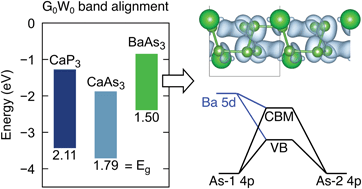Band alignment of monolayer CaP3, CaAs3, BaAs3 and the role of p–d orbital interactions in the formation of conduction band minima†
Abstract
Recently, a number of new two-dimensional (2D) materials based on puckered phosphorene and arsenene have been predicted with moderate band gaps, good absorption properties and carrier mobilities superior to those of transition metal dichalcogenides. For heterojunction applications, it is important to know the relative band alignment of these new 2D materials. We report the band alignment of puckered CaP3, CaAs3 and BaAs3 monolayers at the quasiparticle level of theory (G0W0), calculating band offsets for isolated monolayers according to the electron affinity rule. Our calculations suggest that monolayer CaP3, CaAs3 and BaAs3 all form type-II (staggered) heterojunctions which makes them suitable for solar-energy conversion applications. Their quasiparticle gaps are 2.1 (direct), 1.8 (direct) and 1.5 eV (indirect), respectively. We also examine trends in the electronic structure in the light of chemical bonding analysis. We show that the indirect band gap in monolayer BaAs3 is caused by relatively strong As 3p–Ba 5d bonding interactions. Our results provide guidance for the design of phosphorene-like materials and their heterojunction applications.



 Please wait while we load your content...
Please wait while we load your content...